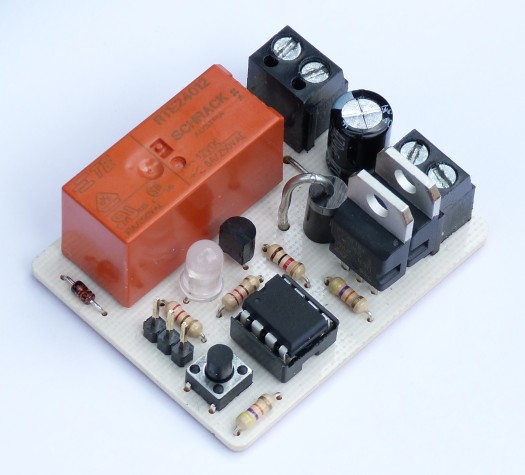|
|
The original project which was primarily designed by Alan Bond for marine use in radio controlled model boats has been re-visited and a number of improvements made in the light of operating experience. Forge Electronics is grateful to Mike Spencer for his invaluable help. The unit features the following
The Unit will shortly be available for the Scale Warship Store
|
Two power MOSFETs are now used in parallel to reduce the conduction power losses such that heatsinking is not required which further enables fitting to a 3D printed base to avoid shorts Likewise, restricting operation to marine applications allows a smaller flyback diode to be used without a heatsink. There is no BEC included.So, apart from the packaging benefit, what operating improvements have been made to offset the compromises made?Instead of using a potentiometer to set neutral over a relatively narrow range, this can now be done at any time by use of a push-button. The range over which neutral can be set has been increased to allow 70/30 pistol type controllers to be used. These are the type usually supplied with model cars which are sometimes included with RTR (ready to run) boats which give forward control over 70% of the trigger movement and reverse is limited to 30% trigger movement which thereby restricts reverse speed to just under half (30/70ths)A further set-up routine can be entered at any time by a longer press of the push-button. In this mode the span of the transmitter joystick can be calibrated such that full drive is achieved at precisely each extreme of the joystick. Without span setting, depending on the transmitter it may not be possible to achieve full drive in one or both directions or alternatively full drive may occur before full travel of the joystick is reached resulting in a dead-zone.A second function in the set-up routine allows the user to set the maximum speed in both forward and reverse directions. This is primarily of benefit in the reverse direction to prevent accidental application of full reverse throttle causing the stern to be swamped, avoiding a possible sinking. Also the performance of a swift and powerful boat can be ‘tamed’ to suit a novice user.A dual LED is now used to assist with the set-up of the unit and indicate its operating status. Green indicates ‘forward’ and red indicates ‘reverse’. Both LEDs on together (Orange) indicate neutral. When under way, the appropriate forward or reverse LED flickers to indicate the commanded direction, going ‘solid’ to indicate the full drive condition.To accommodate 2.4GHz radio systems, the unit remains dormant for the first 5 seconds after switch-on to allow the receiver to ‘boot’ up and assert its correct outputs rather than those dictated by the ‘fail-safe’ regime. As most RC systems are aimed at model aircraft applications, their idea of a safe closed throttle condition at switch on equates to full reverse in the boating world! The two LEDs flicker alternately during this start-up delay, occluding briefly to indicate the passage of each second.As an additional safety measure, the speed controller needs to see the neutral condition before it will ‘arm’ – ie after the 5 second start-up delay it will not run the motor if the joystick has been left in other than the neutral position. The red/green LED appropriate to the joystick displacement will be ON prior to ‘arming’. Once the joystick is centred on neutral the relays will give a brief ‘buzz’ to indicate arming of the unit and both LEDs will be ON to indicate neutral.This PICAXE based project supports batteries in the range 6v to 12v and uses a relay to achieve reversing. Neutral (indicated by a red LED) is adjustable in the range 1.4mSec to 1.6mSec and has a small deadband to prevent 'creep'. The same circuit has been used with 30A automotive relays and better rated MOSFET, Schottky flyback diode and heatsinks for higher current applications,To give the relay an easy life, when direction changes are commanded, the PWM drive shuts down briefly prior to the relay being operated and sufficient time is then allowed for the contacts to finish 'bouncing' prior to PWM drive being re-asserted. Manufacturers quote relay ratings *switching* but in this design the motor current at the time of switching is zero, and the relay's *carrying* capacity is far greater than its "8A" label suggests. The last statement is substantially true in the case of marine applications where there is very little inertia in the drive train and a moving boat doesn't back-drive the propeller, however in robot type applications substantial dynamo action can occur which will result in the relay contacts having to switch high currents - so beware! Likewise the power dissipation in the Schottky flyback diode D1 would then need watching too.A PICAXE 08M microcontroller processes the r/c speed demand input and sets up the appropriate PWM drive signal. The relay is de-energised in neutral, but to prevent continual clicking if 'inching' the boat in reverse it remains energised when entering neutral (from reverse) for a period of four seconds. A transistor buffer is used to condition the signal from the receiver. The output voltage swing of some receivers (especially 2.4Ghz types) has been found to be insufficient to trigger the PICAXE 08M (Schmitt Trigger type) input. |


